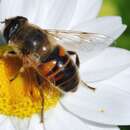The drone fly (
Eristalis tenax) is a hoverfly native to Europe, and is now established worldwide. The drone fly is so named because it is thought to mimic the European honey bee drone (
Apis mellifera), with a black and yellow striped body and similar flight patterns. The adult fly eats pollen and is a common visitor to flowers, especially yellow ones, making it a significant beneficial pollinator. Two or three generations of drone flies occur each year, with the females laying about 20 eggs in masses next to fouled water or decaying organic material, such as in manure lagoons or holding pits in livestock areas. The aquatic drone fly larvae are a cylindrical shape, about 2 cms long and notable for their long “tail”, a specialized respiratory structure several times the length of their body, which functions as a breathing straw to allow the larvae to breathe air from the surface while filter feeding in anoxic conditions. The tail gives these larvae their common name: rat tailed maggots. The larvae migrate onto drier land to pupate, usually just under the ground, and the pupae retain the tail, locked into a loop over the body. In large numbers, migrating larvae sometimes become a nuisance in that they contaminate livestock feed. Rare cases of accidental, benign, and often asymptomatic myiasis (inhabitation of a living vertebrate host) have been reported for this insect, thought to occur by ingestion of food or water contaminated with larvae. These cases are easily treated. (Aguilera, Cid and Regueiro 1999;
Grissell, and Fasulo 2010; Ilse 1949;
Wikipedia 2011)

